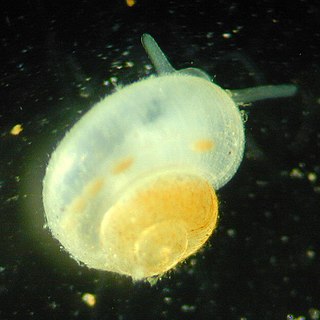
The Amblyopsidae are a fish family commonly referred to as cavefish, blindfish, or swampfish. They are small freshwater fish found in the dark environments of caves, springs and swamps in the eastern half of the United States. Like other troglobites, most amblyopsids exhibit adaptations to these dark environments, including the lack of functional eyes and the absence of pigmentation. More than 200 species of cavefishes are known, but only six of these are in the family Amblyopsidae. One of these, Forbesichthys agassizii, spends time both underground and aboveground. A seventh species in this family, Chologaster cornuta, is not a cave-dweller but lives in aboveground swamps.

Powelliphanta is a genus of large, air-breathing land snails, pulmonate gastropods in the family Rhytididae, found only in New Zealand. They are carnivorous, eating invertebrates, mostly native earthworms. Often restricted to very small areas of moist forest, they are prey to introduced mammalian predators, and many species are threatened or endangered.

The Tumbling Creek cavesnail is a species of freshwater cave snail with gills and an operculum, an aquatic gastropod mollusk in the family Amnicolidae.
Beddomeia camensis is a species of very small freshwater snail that is endemic to Australia. The invertebrate is 2-4 mm in size, it is a gastropod mollusk and belongs to the Hydrobiidae family, a large family of freshwater snails recognised by their small size and cosmopolitan distribution. Beddomeia camensis is one of the least populated species within its family distributed across only 5 small to medium-sized streams that flow into the Cam River catchment in North-West Tasmania.

Beddomeia fultoni(B. fultoni) is a species of small freshwater snail belonging to the family Tateidae.

Beddomeia hallae, also known as Buttons Rivulet hydroboiid snail, is a species of small freshwater snail that is endemic to Australia. The species is an aquatic operculate gastropod mollusk in the family Hydrobiidae. Beddomeia hallae belongs to the genus Beddomeia, which is the largest group in the family Hydrobiidae, consisting of 47 species. In the Threatened Species Protection Act 1995, this species is one of the 37 Beddomeia species listed as endangered, however, on the International Union for Conservation of Nature Red List, the species is listed as vulnerable. Found in Tasmania, in the streams of Buttons Rivulet and Castra Rivulet, Beddomeia hallae is sighted in its natural habitat amongst wood, leaves and under stones. Nonetheless, the Beddomeia species including Beddomeia hallae are geographically isolated, existing within restricted ranges.
Beddomeia launcestonensis is a species of very small freshwater snail that has a gill and an operculum, an aquatic operculate gastropod mollusk in the family Hydrobiidae. This species is endemic to Australia.
Carnarvonchochlea exigua, more commonly known as Jardinella exigua is a small freshwater snail residing in North East Queensland, near Carnarvon Gorge. Carnarvoncochlea refers to the location of origin, whilst exigua derives from the latin word “exigus” meaning “small”.
Unthanks Cave Natural Area Preserve is a 171-acre (69 ha) Natural Area Preserve in Lee County, Virginia. It protects the entrance to Unthanks Cave, which houses significant biological diversity and a wide variety of invertebrate life. The cave's streams drain a significant karst area south of the Powell River.

The Maitai River is the largest river in the city of Nelson, in the north of New Zealand's South Island. The river stretches from the Bryant Range, situated to the east (inland) of Nelson, where it flows towards the city, flowing west through the heart of the city and into the Tasman bay at Nelson Haven. The catchment of the river covers some 9000 hectares, and has two branches in the upper catchment, the north meets a dam, where the south travels west into the middle catchment, from where it takes its final journey through the urban area of the city before meeting the ocean.

Catapyrgus sororius is a critically endangered species of fresh water snail endemic to New Zealand.

Hadopyrgus rawhiti is a critically endangered species of freshwater snail native to New Zealand.
Opacuincola cervicesmadentes is a critically endangered species of freshwater snail endemic to New Zealand.
Opacuincola dulcinella is a critically endangered species of freshwater snail endemic to New Zealand.

Opacuincola eduardstraussi is a critically endangered species of fresh water snail native to New Zealand.
Potamopyrgus acus is a critically endangered species of fresh water snail native to New Zealand.
Potamopyrgus doci is a critically endangered species of fresh water snail native to New Zealand.
Hadopyrgus is a genus of white or transparent freshwater snails found only in New Zealand. They are micromolluscs, just a few millimetres long, in the gastropod family Tateidae. Hadopyrgus species are subterranean – living in caves, underground aquifers, or deep in river gravels – and so were named from the Greek hades (underworld) and pyrgos (tower). They can have quite restricted ranges: Hadopyrgus ngataana, for example, has been found in just one pool, in a stream flowing through a single cave.

Potamopyrgus oppidanus is a species of freshwater gastropod mollusk in the family Tateidae. It is endemic to New Zealand where it is found only in one area in the town belt of Wellington.
Catapyrgus is a genus of gastropods belonging to the family Tateidae.












